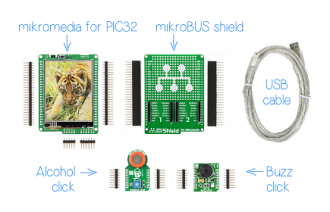
We strongly encourage users to use Package manager for sharing their code on Libstock website, because it boosts your efficiency and leaves the end user with no room for error. [more info]

Rating:
Author: MIKROE
Last Updated: 2016-02-23
Package Version: 1.0.0.0
Category: Measurement
Downloaded: 932 times
Followed by: 1 user
License: MIT license
Is there such a thing as the Ballmer peak? It's the idea that moderate alcohol consumption has a benefitial impact on creativity, and hence, on programming ability. The theory was explained in this issue of the xkcd webcomic. We devised a practical test to examine the validity of the assumption.
Do you want to subscribe in order to receive notifications regarding "Let's make - Breathalyser" changes.
Do you want to unsubscribe in order to stop receiving notifications regarding "Let's make - Breathalyser" changes.
Do you want to report abuse regarding "Let's make - Breathalyser".
| DOWNLOAD LINK | RELATED COMPILER | CONTAINS |
|---|---|---|
| 1405463542_let_s_make___bre_mikroc_pic32.zip [133.37KB] | mikroC PRO for PIC32 |
|
| 1405466416_let_s_make___bre_mikrobasic_pic32.zip [135.21KB] | mikroBasic PRO for PIC32 |
|
| 1405463528_let_s_make___bre_mikropascal_pic32.zip [135.50KB] | mikroPascal PRO for PIC32 |
|

All you need is a mikromedia for PIC32, a mikroBUSâ„¢ shield, an Alcohol click, and a Buzz click. And of course, a moderate quantity of alcohol (choose your own form factor).
View full imageThe Ballmer peak is the supposed sweet spot of BAC (blood alcohol content) that causes a sharp increase in programming ability. It was best explained in the famous xkcd comic.
It's a delicate effect because the peak is preceeded and followed by a productivity slump, so you have to calibrate your dosage carefuly. Also, it's unattanaible if you're not of legal age to drink so don't even try.
With this project, you can run a few experiments. Follow the procedure like our coder does in this dramatic reenactment: Tackle a problem. Get stuck. Drink a bit. Repeat until you experience some kind of breakthrough. That's your Ballmer peak!